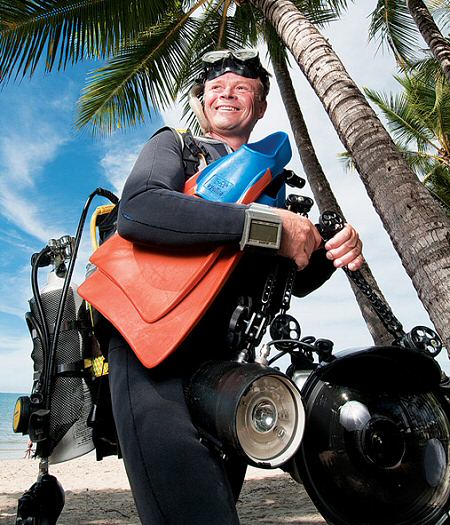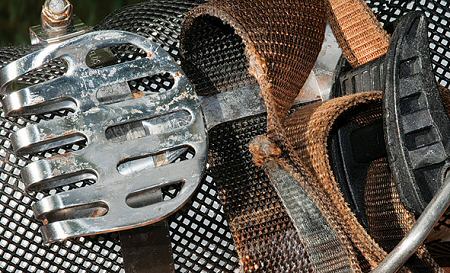Pete Atkinson, 52, is a professional underwater photographer. For 20 years he sailed and dived all over Polynesia – then, five years ago, he sold his yacht, bought a house in Australia and married another photographer, Darin Limsuansub.
He claims not to be a grumpy old man, but his attitude to current dive fashions suggests that he is.
I don’t feel that dive equipment manufacturers serve us well. I live in Cairns, Queensland, a small town with a dozen dive shops, none of which sell fins, a wetsuit or a snorkel I’d want to buy.
I have been diving for 34 years, often alone, often feeding sharks, often far from any hyperbaric chamber.
I have done drift dives alone in the passes of the Tuamotus from a 2.5m home-made plywood rowing dinghy. If I hadn’t been careful, I doubt I’d be writing this.
Disclaimer: following these dive practices could be hazardous to your health…
REGULATORS
I have never had a regulator professionally serviced. I regard servicing as parasitism on diving. Liability paranoia forces many service centres to replace everything made of rubber, whether it’s needed or not, at huge cost.
My first regulator was a US Divers Conshelf. Apart from high-pressure seat longevity, this was great.
I bought another, plastic this time, which was not an improvement.
Now I have the US Divers Titan which, like all good regs, just does the job without having attention paid to it.
With a gauge for setting the intermediate pressure, most people could service their own regulator.
lthough I have an octopus to keep trip directors happy, I think they’re a waste of money and baggage allowance.
My pony has an Oceanic Swivel regulator. This keeps some dive operators happy enough for me to dive alone, but it’s there for show; it doesn’t get much use.
The other day I pressed the purge button, and it disintegrated with the consistency of hard Cheddar cheese.
If manufacturers insist on using plastic, perhaps they could use a higher grade.
The pony reg has a tiny Apeks hp gauge screwed into the first stage. I would have bought a pony band had I been able to find one locally.
Instead, I bought a stainless-steel frying spatula for 50p, and bent it to the required shape (left).
BC
For years in the tropics I did most of my dives without a BC, just a plastic backpack and a small tank. With a thin suit, any buoyancy adjustment could be done with my lungs.
Once I started diving with dive operators, I used cast-off BCs from [wildlife photographer] Tobi Bernhard.
More recently, I bought a Seaquest Passport for its light weight, but I prefer my wife’s Scubapro Ladyhawk, though it’s too small for me to use with a suit.
WETSUITS
Although I learned to dive in the UK, most of my diving is in the 24-30°C range. For years I had custom wetsuits made in Fiji, 3 or 5mm, front zip, one-piece.
Why must we put up with idiotic surfing suits with back zips? How the hell are you meant to take a pee, regulate your temperature or stash your bag of sardines with a back zip?
Here in Cairns, not one shop has a 3mm front-zip one-piece.
Talking of surf fashions, it’s trendy to wear board shorts. How comfortable are these when stuffed into a wetsuit? Budgie-smugglers (as Speedos are known here) are far better.
It’s not that young people are modest – look at their hair!
COMPUTERS
I came to dive computers fairly late, with an Aladin Pro. I like this, because I don’t need to know how it works – it just gives me the information I need, when I need it, at a size I can see.
There are no fiddly buttons to break.
The first time it had a new battery (not user-serviceable) I could wear the cost, but last time I felt £75 for a £6 battery was outrageous, so I replaced the battery myself, and it works fine.
You can find instructions (in French) online.
MASK
I use a black Oceanic mask with corrective lenses. For years I told myself: “I don’t shoot macro now because it doesn’t sell”, whereas the truth was, I simply couldn’t see small stuff any more.
One thing I hate: you find a piece of gear (or clothing) you love, but when you go to replace it later, the design has gone the way of the dodo and been “improved” out of existence.
FINS
I currently use the best fins I have ever used, but no dive store in Cairns will stock them, as they aren’t profitable enough.
They are orange and blue, Malaysian rubber fins by Eyeline, available from a local sports shop for £20.
From new, I could snorkel for a couple of hours without any hint of blisters. They are stiff enough that I can push a Seacam housing around all day.
For the diving I do, such full-foot fins are by far the best. Manufacturers continue to dream up fancy expensive gimmicks to extract more money from us. I’ll concede that a few of these might actually be useful but, offhand, I can’t think of any.
SNORKEL
When my wife learned to dive, she was sold a £60 snorkel. Instructors make commissions; everyone else makes grotesque profits exploiting vulnerable new divers: “Without this, you’ll die!” Just finding a simple J-snorkel for an adult is impossible in Cairns.
SAFETY GEAR
With idle factories in China, how hard would it be to make a 100m-depth-rated, small, submersible, single-channel VHF radio, charged through external contacts like a Kowalski torch?
In almost every instance in which divers are lost and are alive, they can see the boat. If they can then direct the search vessel, they don’t need to spend hours bobbing around in “shark-infested” waters.
A metallised inflatable polypropylene kite would fold up to the size of a safety sausage, could be launched from the sea and be radar-reflective.
How hard is this? And having made something useful, dive-equipment manufacturers could then make the radios in different colours to match your fins, replacement coloured strings for the kite…


